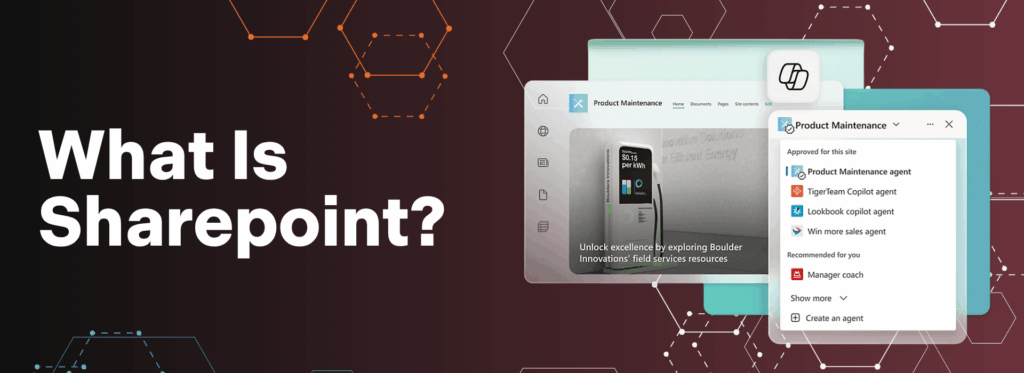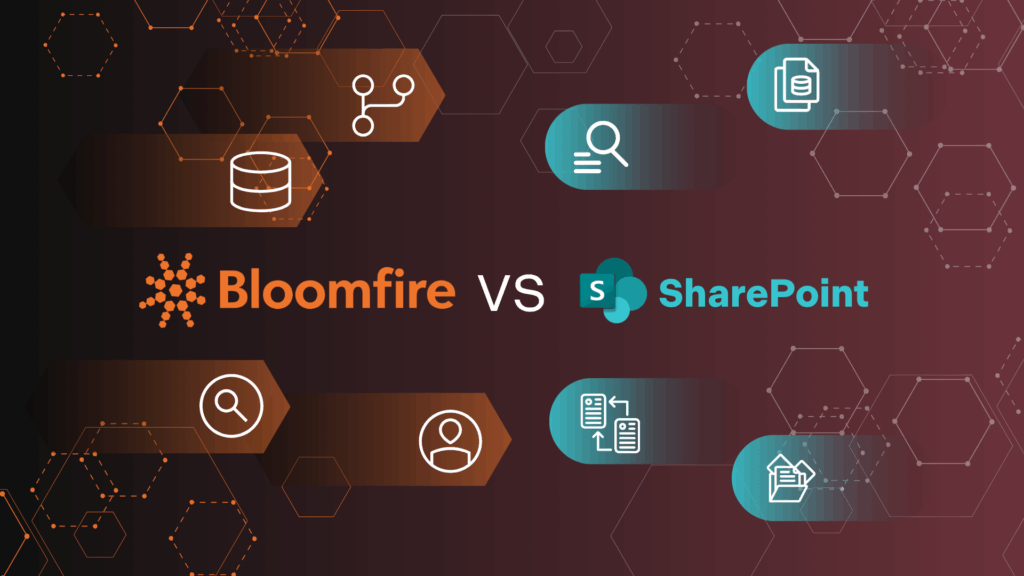What Is SharePoint? A Guide to Its Use as a Knowledge Management Tool

Microsoft SharePoint is a platform developed by Microsoft that enables organizations to manage content, collaborate across teams, and build internal sites. It’s commonly used as a document management and intranet solution within the Microsoft 365 suite, often paired with tools like Outlook, Teams, and OneDrive.
With the addition of Copilot, Microsoft’s AI assistant, SharePoint has expanded its capabilities in AI-driven content creation and search. However, as a general-purpose tool, SharePoint’s knowledge management capabilities may fall short for enterprises seeking scalable, structured, and easily discoverable information across departments.
Learn more about SharePoint and whether it’s the right KM platform for your company.
Pros and Cons of SharePoint
SharePoint provides a comprehensive set of capabilities for teams integrated into the Microsoft ecosystem. But many organizations struggle with adoption, governance, and delivering meaningful ROI—especially when it comes to search and day-to-day content usability.
Pros
- Microsoft ecosystem integration: Seamless collaboration across Teams, OneDrive, Outlook, and more.
- AI-enhanced search: Copilot introduces improved discovery capabilities, assuming content is structured and tagged correctly.
- Site customization: Organizations can create internal sites and content layouts tailored to departments or projects.
- Enterprise-grade administration: Offers detailed permissioning, version control, and metadata tagging.
Cons
- Steep learning curve: Non-technical users may struggle to build, maintain, or navigate SharePoint environments without heavy IT support.
- Low user satisfaction: Users often encounter confusion, clutter, and difficulty finding what they need—especially in large orgs with sprawling SharePoint sites.
- Inconsistent AI output: Copilot’s usefulness depends on well-maintained, structured content, which is often lacking.
- ROI challenges: Despite its features, SharePoint requires a high resource investment and often fails to meet expectations for productivity and insight activation.
- Customer support tiering: Advanced support is available only through premium contracts, and the quality of support varies accordingly.
Evaluating both the advantages and drawbacks of SharePoint helps organizations better anticipate implementation needs, skill gaps, and content governance challenges—especially if AI is part of their future KM strategy.
Need More Than a Portal?
Learn how Bloomfire brings clarity and control to your SharePoint knowledge.
Talk to an ExpertKey Features of SharePoint with Copilot
Key SharePoint features include integration with Microsoft 365 apps, document libraries, permission management, and customizable site creation, though many of these require specialized training or IT involvement to set up and maintain.
- AI Content Creation: Copilot assists with formatting content into SharePoint pages and auto-suggesting layouts.
- Advanced Permissions: Flexible controls for access, editing, and visibility across sites and files.
- Metadata Management: Users can apply categories, keywords, and content types to organize materials—though manual tagging is often required.
- Microsoft 365 Integration: Tight SharePoint integrations with Outlook, Teams, Power BI, and Excel enhance collaboration and data access within the Microsoft ecosystem.
These capabilities provide SharePoint with a strong infrastructure and extensibility—but they do little to address knowledge clarity, usability, and engagement on their own.
SharePoint Pricing Plans: What You Need to Know
SharePoint is included in several Microsoft 365 packages, but often requires additional costs and custom development to meet KM needs.
- Microsoft 365 Business Basic/Standard: SharePoint Online access is included, with limited admin customization options available.
- Microsoft 365 E3/E5: Offers broader enterprise capabilities and Copilot integration at higher per-user pricing.
- Add-ons & custom development: Building useful SharePoint sites often involves consultants, third-party tools, and training programs.
The true SharePoint cost is often underestimated when accounting for long-term maintenance, IT support, and external consultant fees required to scale its functionality.
SharePoint Reviews: What Users Are Saying
According to insights from trusted software review sites like G2 and Capterra, SharePoint is widely recognized for its deep integration with Microsoft 365 and its robust document management capabilities. Many users highlight its advanced search functionality, especially with the addition of Copilot, and appreciate its compatibility with tools like Teams and OneDrive.
However, users also report recurring issues that limit SharePoint’s value as a knowledge management system:
- Steep learning curve: Several users note that setting up SharePoint effectively requires expertise in information architecture and development resources—making it less accessible for non-technical teams.
- Content sprawl and confusion: Many organizations struggle with content duplication, inadequate version control, and cluttered websites, which compromise discoverability and result in wasted time.
- Underwhelming user experience: Reviews commonly mention the unintuitive interface, which results in poor adoption among general employees.
- Copilot limitations: While Copilot improves the user experience in theory, reviews suggest inconsistent performance in surfacing useful knowledge, especially when the content itself isn’t well structured.
- Support tiers: Some users are frustrated with Microsoft’s customer support structure, which often requires premium contracts for meaningful help.
These reviews suggest that while SharePoint remains a strong choice for document storage and compliance-focused intranets, it is often insufficient as a stand-alone knowledge management platform—especially at enterprise scale. Many teams turn to complementary platforms like Bloomfire to bring structure, engagement, and AI-readiness to their SharePoint content.
A SharePoint Alternative: How Bloomfire Compares

Bloomfire works alongside or in place of SharePoint—providing the structured knowledge layer that SharePoint lacks.
| Feature | Bloomfire | SharePoint |
|---|---|---|
| User Experience | Intuitive and modern | Complex and admin-heavy |
| Search | Deep-indexed across formats, including spoken word | Tag-dependent, struggles with unstructured content |
| AI Outputs | AI surfaces and recommends content | Copilot performance is content-dependent |
| Customization | Drag-and-drop homepage builder | Requires skilled developers for custom sites |
| Governance | Self-healing content tools, auto-expiry | Manual cleanup, no ROT detection |
| Implementation | Guided onboarding, no-code setup | Long ramp-up, requires SharePoint expertise |
Here’s a comparative analysis to help you decide which platform might be better suited for your organization:
Platform focus & ideal users
This section outlines the core design principles of SharePoint and Bloomfire, as well as the types of organizations that are best suited for each.
Bloomfire: A purpose-built knowledge management platform, Bloomfire is ideal for enterprises that need secure, scalable, and AI-ready access to knowledge. It serves industries where speed-to-knowledge, search accuracy, and user engagement are critical—such as healthcare, financial services, retail, and customer experience teams.
SharePoint: SharePoint is primarily positioned as a broad collaboration and document management tool within the Microsoft 365 suite. It’s best suited for organizations with strong IT resources that prioritize compliance, intranet-style content storage, and tight integration with Microsoft apps over user-friendliness or scalable knowledge sharing.
User interface & customization
This assesses the degree to which each platform allows customization of appearance and user experience.
Bloomfire: Offers a fully configurable, drag-and-drop homepage that surfaces featured content, shared feeds, embedded media, and strategic insights. Its intuitive design encourages engagement and adoption with minimal training, making it usable by non-technical roles across departments.
SharePoint: SharePoint sites are customizable, but building an effective UX often requires developer support and internal expertise in information architecture. Without dedicated oversight, content layouts can become inconsistent and overwhelming, leading to low engagement.
Search experience
This evaluates how well each platform helps users find relevant content—quickly and accurately.
Bloomfire: Uses a proprietary deep-indexed search engine that surfaces results from 29+ content types, including spoken words in videos and audio files. Users can view keyword previews, filter intuitively, and access high-value content with a single click.
SharePoint: With Copilot, SharePoint’s search has improved, but still relies on well-structured content and metadata to deliver results. Many users report frustration with inconsistent accuracy and a high reliance on expert setup to utilize Copilot fully.
Q&A Functionality
This refers to how users surface and preserve questions and answers as reusable knowledge.
Bloomfire: Promotes collaborative Q&A, allowing anyone to ask questions and crowdsource answers from subject matter experts. These Q&As are automatically indexed and made searchable, helping build a living knowledge base.
SharePoint: Lacks a native, scalable Q&A mechanism. Questions may appear in discussion boards or Teams threads, but they are not easily indexed or made findable across the ecosystem, limiting their long-term value and visibility.
Implementation Services
This highlights the onboarding experience and support structure for each platform.
Bloomfire: Offers high-touch onboarding through a dedicated implementation team that helps with content migration, platform setup, governance strategy, and change management. Bloomfire’s Ignition Sequence ensures your platform is tailored to your teams’ needs and delivers fast time-to-value. This onboarding approach simplifies adoption and drives early engagement, particularly among departments new to knowledge management systems.
SharePoint: Requires internal technical expertise to set up and maintain. Microsoft offers documentation and community resources, but hands-on support is tiered and often requires additional enterprise-level service contracts. Many teams need consultants or developers to tailor SharePoint for KM use cases.
Unlike SharePoint’s more generalized approach and dependency on custom development, Bloomfire is purpose-built to make knowledge accessible, structured, and actionable—without burdening IT. Its ease of use, deep indexing, collaborative features, and dedicated support make it a strong complement—or alternative—to SharePoint for enterprise knowledge management.
Is SharePoint Right for Your Organization?
SharePoint is well-suited for organizations that require a flexible document repository and already heavily utilize Microsoft 365. However, when teams require structured, scalable knowledge management that supports rapid search, AI accuracy, and high engagement, it often falls short due to SharePoint’s disadvantages in usability and governance.
That’s where Bloomfire comes in. Whether augmenting SharePoint or replacing it entirely, Bloomfire unlocks content clarity and empowers enterprise knowledge at scale.
Top KM Platforms Ranked
See how SharePoint stacks up against 9+ knowledge management solutions.
Get the Guide

Enterprise AI Search: Definition, Benefits, and Evolution

The Benefit of Company-Wide Knowledge Management in 2026

Are You Making These Common Knowledge Sharing Mistakes?

Estimate the Value of Your Knowledge Assets
Use this calculator to see how enterprise intelligence can impact your bottom line. Choose areas of focus, and see tailored calculations that will give you a tangible ROI.

Take a self guided Tour
See Bloomfire in action across several potential configurations. Imagine the potential of your team when they stop searching and start finding critical knowledge.